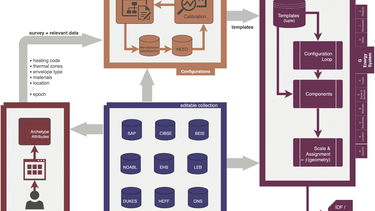Multiscale Simulation
The Multiscale Simulation group is made up of a diverse group of researchers. It is involved in modelling and simulation across various scales, from the building level to neighbourhood, urban and regional scales.

Research
PyClim
PyClim is intended as a resource for architectural, engineering, and technology students and practitioners, to help develop early-stage bioclimatic design concepts.
Based around the Matplotlib library, PyClim is organised around the following modules:
- ClimAnalFunctions: functions relating to solar geometry, psychrometry and illumination.
- Psychros: creates psychrometric charts for the plotting ot climate data, and of transformed data to mimic evaporative cooling.
- SolarIrradiation_Aniso: creates solar irradiation surface plots of annual irradiation incident on a tilted plane solar collector.
- Sunpath: creates sunpath diagrams in stereographic projection; plotting time lines either according to solar or clock time; this latter representing the Analemma, calculated using the equation of time (EqT).
- SolarGeo_subplots: creates a 3x2 grid of subplots: the first three plotting daily variations in declination, EqT and solar daylength; the latter three plotting hourly solar altitude, azimuth and cosine of the angle of incidence on a collector.
- WeatherAnalysis: creates a range of plots and statistics of climate variables:
- temporal solar irradiance / maps
- violin plots of key synoptic variables
- monthly degree-day bar charts
- inverse illuminance cumulative distribution function: determines light switch-off hours
- wind speed / temperature frequency histograms
- ground temperature profile.
- WindRose: plots a user-controllable wind rose, with theta segments of azimuthal sectors falsecoloured either according to the hours that the wind approaches that direction and in the indicated (theta) speed, or at the indicated (theta) temperature.
View the PyClim source code.
Integrated assessment
Supporting urban sustainability across scale using system dynamics.
Recent publications
- PyClim: An open-source climate analysis toolkit
-
Darren Robinson and Kate Bobyn, September 2020.
Conference paper in Building Simulation and Optimisation 2020 Conference Proceedings.
Abstract
An important first step in bioclimatic building design, is the analysis of climate data - to identify the opportunities and the threats posed by the climate at a given site location.
Following a brief review of related climate analysis tools, this paper describes the structure and basis of PyClim, a modular open source Python-based toolkit for the analysis of climate data, and demonstrates its application; both standalone and via a web-interface.
It is hoped that both the source-code and interface will be a useful resource to architectural science students and bioclimatic design practitioners.
- Emulation-based uncertainty and sensitivity analysis of a multi-zone dwelling
-
Parag Wate and Darren Robinson, August 2020.
Conference paper in IBPSA-England Building Simulation and Optimization 2020 Proceedings.
Abstract
Computer models of building thermal phenomena are increasingly coupled with the other domain specific models, for instance of occupants’ stochastic behaviours, improving the plausibility of energy performance simulation results, but at the cost of increased complexity, in terms of the number of required inputs and computational expense.
Model complexity may also result in unanticipated predicted behaviours, as the inputs are inherently uncertain.
To improve the reliability of energy predictions under uncertainty, and thus to contribute to efforts to address the so-called energy performance gap, a pragmatic treatment of uncertainty in building energy simulation should:
- simulate the involved thermal phenomena at an appropriate level of complexity,
- rank the importance of and quantify the effects of parameters in the uncertain parameter space, accounting for their interactions,
- do this in a computationally tractable manner.
To this end, this paper introduces a new two-stage Emulation based Uncertainty and Sensitivity Analysis (EmUSA) framework.
The first stage involves a systematic dimensionality reduction of the uncertain parameter space, by segregating the most influential parameters from their less-influential counterparts, using parameter screening.
In the second stage a Gaussian Process emulator of a stochastic building performance simulator (EnergyPlus coupled with the Multi-Agent Stochastic Simulator No-MASS) is constructed and applied to the reduced parameter space, to efficiently perform a global uncertainty quantification study.
After describing this new framework, we demonstrate its application to study both aleatory and epistemic uncertainty to inputs describing a multi-zone residential building energy model; closing with a discussion of the results.
Emulation-based uncertainty and sensitivity analysis of a multi-zone dwelling
- Enhanced EnHub: dynamic simulation of housing stock energy systems
-
Gustavo Sousa and Darren Robinson, July 2020
Enhanced EnHub: dynamic simulation of housing stock energy systems
- Framework for emulation and uncertainty quantification of a stochastic building performance simulator
-
Parag Wate, M Iglesias, V Coors and Darren Robinson, January 2020
- Entropy and its application to urban systems
-
Ben Purvis, Yong Mao and Darren Robinson, January 2019
Team
Dr Ben Purvis, Research associate
Reena Sayani, PhD research student
Sergio Poco Aguilar, PhD research student




